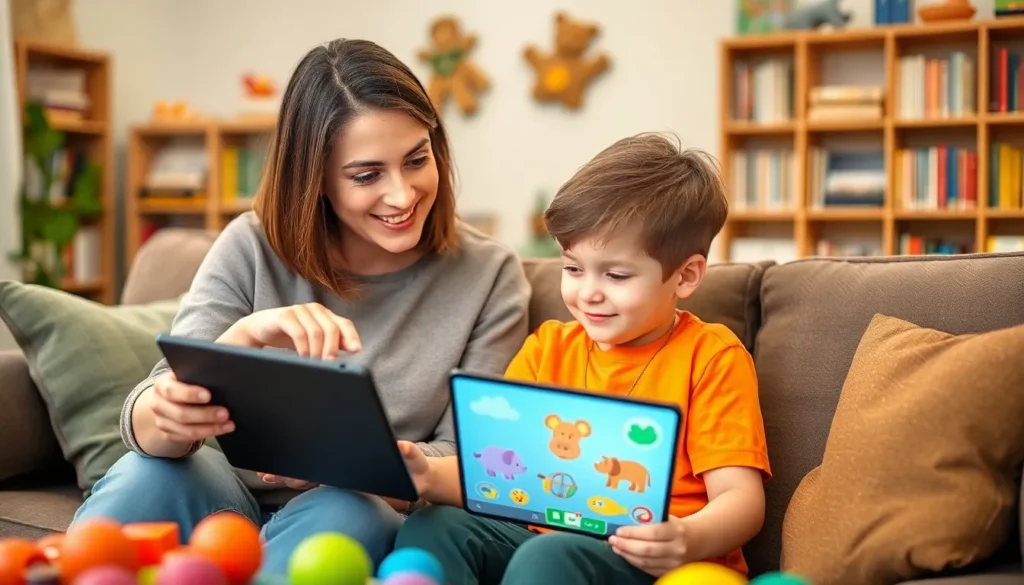Table of Contents
ToggleIn a world where screens are as common as peanut butter and jelly sandwiches, figuring out a screen time schedule for kids can feel like a game of whack-a-mole. Parents want their little ones to enjoy the wonders of technology without turning them into couch potatoes. The key lies in finding that sweet spot—enough screen time for fun and learning, but not so much that they start speaking in emoji.
Importance Of Screen Time Schedule For Kids
A well-structured screen time schedule supports children’s overall development. It guides parents in creating a balanced approach to technology use, ensuring kids reap benefits while minimizing risks.
Cognitive Development
Screen time can enhance cognitive skills when used correctly. Educational apps and games foster critical thinking and problem-solving abilities. Engaging with interactive content promotes creativity and improves attention spans. Limiting screen time encourages children to pursue other activities, such as reading or outdoor play, which also contribute to cognitive growth. Research indicates that children benefit from a balanced mix of digital and real-world experiences, leading to better learning outcomes.
Social Interaction
Establishing a screen time schedule boosts social interaction among kids. Group activities such as video games foster teamwork and communication skills. Screen time can prompt discussions, allowing children to share experiences and ideas with peers or family. Regularly allocating time for offline play strengthens relationships and builds social skills. Studies show that face-to-face interaction remains crucial for emotional development. Balancing screen time with in-person activities aids in cultivating empathy and emotional intelligence.
Recommended Screen Time Guidelines

Establishing screen time guidelines helps create a healthy balance between digital engagement and offline activities for children. These recommendations vary based on children’s ages and emphasize quality content.
Age-Based Recommendations
For children ages 2 to 5, limit screen time to one hour of high-quality programming each day. Kids in this age range benefit from interactive content that promotes learning through play. For school-aged children, ages 6 to 18, parents should set consistent limits on daily screen time, generally suggesting no more than two hours of recreational use. Encouraging breaks during long sessions helps maintain focus and prevents fatigue. Setting these age-specific guidelines ensures children experience screens positively while protecting their health.
Quality Over Quantity
Prioritizing quality content significantly impacts children’s learning and development. Educational programs and apps enhance critical thinking, creativity, and social skills. Above all, parents should choose content that aligns with educational goals and interests. Co-viewing with kids also reinforces understanding and creates learning moments. Avoiding violent or inappropriate material is crucial. Ultimately, focusing on high-caliber content promotes engaging and enriching screen experiences.
Creating A Screen Time Schedule
Establishing a screen time schedule promotes balanced technology use for children. Prioritizing offline activities supports overall development while still allowing for beneficial screen engagement.
Setting Priorities
Selecting high-quality content is essential for maximizing screen time benefits. Parents should focus on age-appropriate educational apps and programs for children. For instance, those ages 2 to 5 should engage in only one hour of quality programming daily, while school-aged children (ages 6 to 18) benefit from limiting recreational screen time to no more than two hours. Assessing content aligns with educational goals, fostering cognitive, social, and emotional development. Engaging in co-viewing allows parents to reinforce understanding and discussions about what children watch, further enhancing learning experiences.
Incorporating Breaks
Integrating breaks into screen time is crucial for maintaining focus and preventing fatigue. Children should take short breaks during extended screen use, especially when interacting with educational content. Breaks allow for physical activity, encouraging movement and reducing sedentary behavior. Suggestions include a 5 to 10-minute pause after every 30 minutes of screen use. Ensuring balanced engagement fosters a healthier relationship with technology. Break activities can include stretching, playing outdoors, or engaging in creative tasks, reinforcing the importance of offline play alongside screen time.
Benefits Of A Balanced Screen Time Schedule
A balanced screen time schedule offers numerous advantages for children. It enhances their learning experiences while fostering essential relationships.
Enhancing Learning Opportunities
Educational programs and apps provide engaging content that supports cognitive development. They stimulate critical thinking skills and encourage creativity through interactive formats. Exposure to high-quality content aligns with educational goals, reinforcing classroom learning. For instance, children can enhance math skills using fun games that apply real-world problem-solving. These tools create an enjoyable learning environment, promoting knowledge retention. Structured screen time makes it easier to integrate educational content into daily routines.
Promoting Family Bonding
Shared screen time brings families closer together through collective activities. Watching movies or playing games as a family fosters communication and teamwork. It creates opportunities for parents to discuss educational themes, reinforcing lessons learned. Moreover, co-viewing encourages meaningful conversations about appropriate content and online safety. Family activities can incorporate technology in a way that also considers offline engagement. Planning screen time around family schedules strengthens connections and builds lasting memories. Balancing these interactions with non-screen activities emphasizes the importance of both forms of engagement.
Establishing a screen time schedule for kids is essential in today’s digital landscape. It allows parents to navigate the challenges of technology while fostering healthy habits. By prioritizing quality content and integrating breaks, families can enhance learning experiences and emotional development.
A balanced approach not only encourages cognitive growth but also strengthens family bonds through shared activities. As parents create these schedules, they lay the groundwork for their children’s success in both the digital and real world. Embracing this balanced perspective will help ensure that screen time remains a positive influence in children’s lives.





